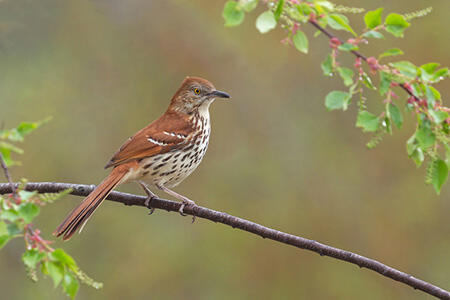- Scientific name: Toxostoma rufum
Species of Greatest Conservation Need (MA State Wildlife Action Plan)
Description

Brown thrasher
Brown thrashers are large songbirds, about 29 cm (11.5 in) long. Adults are rufous above, with light underparts streaked with black, a long, rufous tail, and a relatively long, rather down-curved bill. The sexes are alike in appearance. Brown thrashers are skilled mimics, often with a large repertoire of copied bird songs and other ambient noises.
Life cycle and behavior
Brown thrashers are short- distance migrants, occurring primarily in the eastern United States year-round. Most arrive to the Massachusetts breeding grounds in early May where typically monogamous pairs establish territories and produce 1-2 broods per season. Brown thrashers eat primarily small invertebrates but also will east seeds and fruit.
Population status
In Massachusetts the brown thrasher is a Species of Greatest Conservation Need.
Distribution and abundance
The North American Breeding Bird Survey indicates a declining Massachusetts population trend of -9.8% annually from 1966-2003 (Sauer et al. 2004). Data recorded during the Massachusetts Breeding Bird Atlas (1974-1979) confirmed breeding by brown thrashers in about 30% of the areas surveyed. Brown thrashers were recorded across the state but concentrated in the eastern half of the state and in the lower Connecticut River valley (Petersen and Meservey 2003).
Habitat
Brown thrashers inhabit brushy, early successional areas, such as old fields, hedgerows, pitch pine-scrub oak areas, powerline rights-of way, and other disturbed areas.
Healthy habitats are vital for supporting native wildlife and plants. Explore habitats and learn about conservation and restoration in Massachusetts.
Threats
In Massachusetts, the continuing decline in suitable breeding habitat is the major threat to brown thrashers as early successional habitats are lost to development or to forest succession. Predation by domestic cats has been identified as the largest source of mortality for wild birds in the United States with the number of estimated mortalities exceeding 2 billion annually. Cats are especially a threat to those species that nest on or near the ground.
An additional threat to the species is collisions with buildings and other structures, as approximately 1 billion birds in the United States are estimated to die annually from building collisions. A high percentage of these collisions occur during the migratory periods when birds fly long distances between their wintering and breeding grounds. Light pollution exacerbates this threat for nocturnal migrants as it can disrupt their navigational capabilities and lure them into urban areas, increasing the risk of collisions or exhaustion from circling lit structures or areas.
Conservation
Restoration and management to maintain large tracts of shrubland habitat is the key to brown thrasher conservation in Massachusetts. This includes the conservation and restoration of barrens and oak woodland occurrences across the state, which ideally involves the use of prescribed fire. Managing utility rights-of-way has enormous potential for increasing habitat availability for shrubland birds. Capitalizing on already existing and essentially permanent shrublands should be encouraged whenever possible. Where suitable habitat currently exists, efforts should be made to protect the landscape from development.
Promote responsible pet ownership that supports wildlife and pet health by keeping cats indoors and encouraging others to follow guidelines found at fishwildlife.org.
Bird collision mortalities can be minimized by making glass more visible to birds. This includes using bird-safe glass in new construction and retrofitting existing glass (e.g., screens, window decals) to make it bird-friendly and reducing artificial lighting around buildings (e.g., Lights Out Programs, utilizing down shielding lights) that attract birds during their nocturnal migration.
References
Cavitt, J.F., and C.A. Haas. “Brown Thrasher (Toxostoma rufum).” 2000. The Birds of North America, No. 557 (A. Poole and F. Gill, eds.). Philadelphia, PA: The Birds of North America, Inc.
Petersen, W.R., and W.R. Meservey. Massachusetts Breeding Bird Atlas. Amherst, MA: University of Massachusetts Press, 2003.
Sauer, J.R., J.E. Hines, and J. Fallon. The North American Breeding Bird Survey, Results and Analysis 1966 - 2003. Version 2004.1. Laurel, MD: USGS Patuxent Wildlife Research Center, 2004.
Contact
| Date published: | April 4, 2025 |
|---|